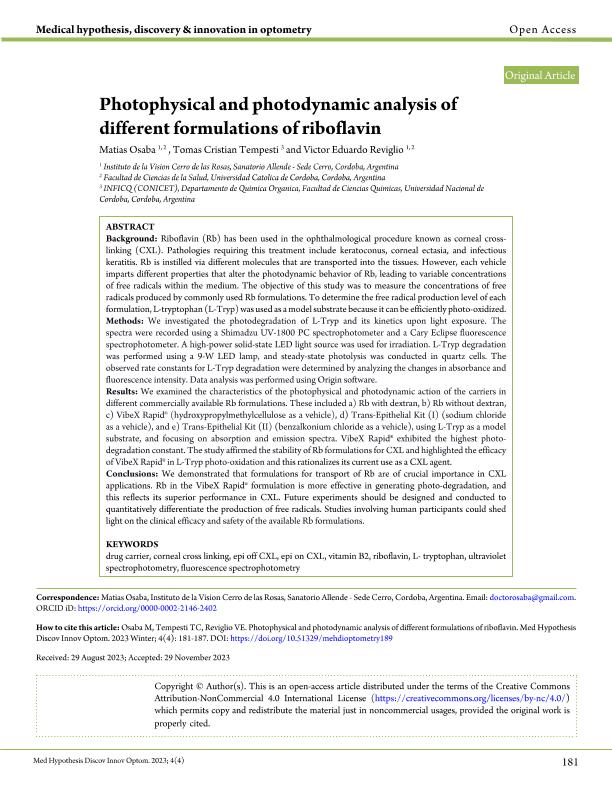Artículo
Photophysical and photodynamic analysis of different formulations of riboflavin
Fecha de publicación:
12/2023
Editorial:
International Virtual Ophthalmic Research Center
Revista:
Medical hypothesis, discovery & innovation in optometry
e-ISSN:
2693-8391
Idioma:
Inglés
Tipo de recurso:
Artículo publicado
Clasificación temática:
Resumen
Background: Riboflavin (Rb) has been used in the ophthalmological procedure known as corneal cross-linking (CXL). Pathologies requiring this treatment include keratoconus, corneal ectasia, and infectious keratitis. Rb is instilled via different molecules that are transported into the tissues. However, each vehicle imparts different properties that alter the photodynamic behavior of Rb, leading to variable concentrations of free radicals within the medium. The objective of this study was to measure the concentrations of free radicals produced by commonly used Rb formulations. To determine the free radical production level of each formulation, L-tryptophan (L-Tryp)was used as a model substrate because it can be efficiently photo-oxidized. Methods: We investigated the photodegradation of L-Tryp and its kinetics upon light exposure. The spectra were recorded using a Shimadzu UV-1800 PC spectrophotometer and a Cary Eclipse fluorescence spectrophotometer. A high-power solid-state LED light source was used for irradiation. L-Tryp degradation was performed using a 9-W LED lamp, and steady-state photolysis was conducted in quartz cells. The observed rate constants for L-Tryp degradation were determined by analyzing the changes in absorbance and fluorescence intensity. Data analysis was performed using Origin software.Results: We examined the characteristics of the photophysical and photodynamic action of the carriers in different commercially available Rb formulations. These included a) Rb with dextran, b) Rb without dextran, c) VibeX Rapid® (hydroxypropylmethylcellulose as a vehicle), d) Trans-Epithelial Kit (I) (sodium chloride as a vehicle), and e) Trans-Epithelial Kit (II) (benzalkonium chloride as a vehicle), using L-Tryp as a model substrate, and focusing on absorption and emission spectra. VibeX Rapid® exhibited the highest photo-degradation constant. The study affirmed the stability of Rb formulations for CXL and highlighted the efficacy of VibeX Rapid® in L-Tryp photo-oxidation and this rationalizes its current use as a CXL agent.Conclusions:We demonstrated that formulations for transport of Rb are of crucial importance in CXL applications. Rb in the VibeX Rapid® formulation is more effective in generating photo-degradation, and this reflects its superior performance in CXL. Future experiments should be designed and conducted to quantitatively differentiate the production of free radicals. Studies involving human participants could shed light on the clinical efficacy and safety of the available Rb formulations.
Palabras clave:
DRUG CARRIER
,
CORNEAL CROSS LINKING
,
EPI OFF CXL
,
RIBOFLAVIN
Archivos asociados
Licencia
Identificadores
Colecciones
Articulos(INFIQC)
Articulos de INST.DE INVESTIGACIONES EN FISICO- QUIMICA DE CORDOBA
Articulos de INST.DE INVESTIGACIONES EN FISICO- QUIMICA DE CORDOBA
Citación
Osaba, Matías; Tempesti, Tomas Cristian; Reviglio, Victor Eduardo; Photophysical and photodynamic analysis of different formulations of riboflavin; International Virtual Ophthalmic Research Center; Medical hypothesis, discovery & innovation in optometry; 4; 4; 12-2023; 181-187
Compartir
Altmétricas




